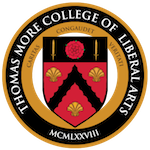By Jacquelyn Oster, Class of 2019
Last Friday, the campus of Thomas More College of Liberal Arts was enlivened by the convivial spark that ignites when each one breaks from his usual routine to reflect on something in common. Refreshed by their exemption from Friday’s classes, students and faculty gathered in the library to explore the Church’s polyphonic tradition with experienced composer and teacher Dr. Kurt Poterack from Christendom College. Dr. Poterack delivered two lectures on Guillaume de Machaut’s fourteenth-century La Messe de Nostre Dame, which is one of the earliest examples of sacred polyphony.
La Messe de Nostre Dame is the first complete, polyphonic mass to be attributed to a single composer. Though Renaissance polyphony is more familiar (and pleasing) to our ears, Machaut’s older composition is striking for its compositional structure and its use of dissonance to create haunting, medieval sounds which are easily distinguished from Palestrina’s soaring melodies.
Machaut transformed the official Gregorian chant of the Church into polyphony by using the original chant as a melody. He lengthened and formed it to repeating, isorhythmic sequences of beats that were held by tenors. Once other, more elaborate harmonies were added, the original chant was no longer recognizable. Its preeminence as a melody was obscured by other layers of music, which built on its foundation. These other layers featured haunting, parallel sequences of fourths and fifths that traveled simultaneously through dissonances and resolutions. The crossing of these strange pairings of notes contributed to the mysterious quality of Machaut’s polyphony.
Dr. Poterack used his evening lecture to speak on the relationship between artistic skill and personal holiness. As a cleric who spent his time writing love madrigals and taking advantage of the benefices of the Church, Machaut failed at his priestly duties; still, he made significant contributions to the Church’s musical tradition. To resolve this seeming incongruity, Dr. Poterack asked the students if the creation of beautiful, sacred art depends on the personal morality of the artist.
It was decided that the artist only needs to possess a rational habit, and that does not necessitate virtuous living. We have observed that many artists like Caravaggio and Michelangelo have left us with splendid testimonies of Truth despite legacies of vice. We also know of countless holy men and women with little to no artistic skill. All that it takes for a cobbler to be good is to make good shoes. His skill in shoemaking does not rely on his virtue.
Fourteenth-century bishops commissioned skilled artists like Machaut to carry out the work that was needed by the Church. Today, there are very few who possess the art of sacred music, but Dr. Poterack’s classes, choral direction, and composition have helped to grow and maintain the Church’s tradition of beauty. TMC is fortunate to have Dr. Poterack as a long-time visitor and friend.
